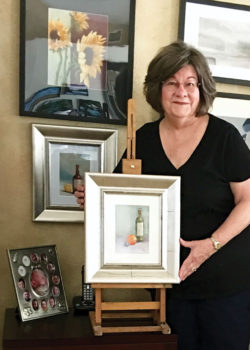
Pastellist Nancy Stifter with several of her paintings
Marianne Graff
From prehistoric cave dwellers to present day Pastelists, art historians continue to explore the methods, materials and successes of the pastel medium. Emily Beeny, Associate Curator of Drawings for the Getty Museum, demonstrates the importance of pastel in the current installation of 18 works: The Birth of Pastel on display until December 17, 2017. The remarks below are based on her article describing the exhibit.
The display contains several colored chalk drawings used either as studies for larger works in oil or finished art pieces. Around 1570 Venetian painter Jacopo Bassano, using blue paper as ground and to establish middle tones, created a design with black chalk and several colors to highlight the figures in Christ Driving the Money Changers from the Temple. About that time a French draftsman, L’Anonyme Lécurieux, created a portrait using only red and black chalk to suggest additional tones of brown, light blue-gray and pink. A delightful chalk drawing by Frederico Barroci employs pink and yellow colors on blue paper to develop the hair, cheeks and arms of a sleeping child, a work used as a study of the infant Jesus in his Madonna of the Cat.
Benedetto Luti’s The Head of an Apostle (1712) achieved both graphic and painterly effects through use of dry colored chalk to draw attention to his beard “where dark, whispery lines contrast with a luminous cloud of white.” Robert Nanteuil, a Parisian artist of the mid-seventeenth century, created pastel portraits. His sensitive work, Portrait of Monseigneur Louis Doni d’Attichy, looks remarkably like an oil painting with “a new richness and variety of touch, effectively conjuring the specific textures and sheens of skin, hair and cloth.” Rosalba Carriera, an important Venetian artist in the early eighteenth century, also used blue paper and developed techniques to illustrate different surfaces such as the luster of pearls or the velvety softness of a cloak. Her Portrait of Lord Sidney Beauclerk (circa 1730) shows great attention to detail. According to the exhibit description, she applied the ground of his garment with wetted pastel and then used a knife or brush handle to create the delicate lace pattern. According to Beeny, “Carriera’s prodigious skill and speed, her knack for flattering likeness made her the favorite portraitist for English aristocrats visiting Venice on the Grand Tour.”
Carriera’s work “exerted a powerful influence on French Pastelists of the subsequent generation,” such as Maurice-Quentin de La Tour, who was named painter to the king in 1750. His Portrait of Gabriel Bernard de Rieux at six and a half feet tall is the largest pastel produced in the eighteenth century and highlights how pastels competed with “contemporary oil portraits on every front: in richness and variety of color and texture, in fineness of detail and finish, above all, of course, in size.” Visitors to this marvelous exhibit will be richly rewarded and gain new insights into the development of Pastel.
